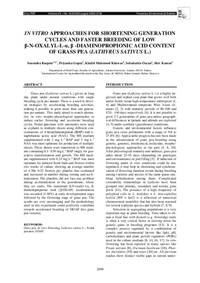In vitro Approaches for Shortening Generation Cycles and Faster Breeding of low β-n-oxalyl-l-α, β-diamino propionic acid content Grass pea (Lathyrus sativus L.).

Authors:
Grass pea (Lathyrus sativus L.) grows as long day plant under natural conditions with single breeding cycle per annum. There is a need to develop strategies by accelerating breeding activities, making it possible to grow more than one generation per annum. This study aimed to search alternative in vitro mopho-physiological approaches to induce earlier flowering and accelerate breeding cycles. Nodal junctions with internodes were used as explants to multiple shoots using different concentrations of 6-benzylaminopurine (BAP) and αnaphthalene acetic acid (NAA). The MS medium supplemented with 2 mg L-1 BAP and 1 mg L-1 NAA was most optimum for production of multiple shoots. These shoots were transferred to MS medium containing 0.1- 0.50 mg L-1 BAP singly for generative transformation and growth. The MS medium supplemented with 0.25 mg L-1 BAP was most optimum for induced floral buds and flowers within two weeks of culture showing an average number of 4.30± 0.32 flowers per plantlet that continued and increased in number during rooting and acclimatization. The plantlets did not face any problem during acclimatization in the greenhouse, where they set seeds. The maximum β-N-oxalyl-l-α, βdiaminopropionic acid (β-ODAP) accumulation was recorded (1.48%) at early developmental stage followed by the flowering stage of grass pea. The results are very encouraging and the methodology used in this experiment could positively contribute towards accelerated breeding of ODAP free grass pea varieties.
